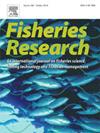Biological traits and population dynamics for sustainable harvesting of Carcinus maenas
IF 2.2
2区 农林科学
Q2 FISHERIES
引用次数: 0
Abstract
Research focusing on the biological patterns and population dynamics of Carcinus maenas has not been conducted for the purpose of fishery management along the European coastal systems. This has led to the implementation of fisheries management policies without scientific considerations, adversely affecting fishery profitability. To addrees this gap, we studied the crab species’ population dynamics, reproductive biology, and growth patterns across different Portuguese lagoons and estuaries on a monthly basis from 2019 to 2021. Surveys were performed in the Southern (Ria Formosa lagoon and Ria Alvor estuary), Central (Sado river/estuary) and Northern regions (Ria Aveiro estuary) of Portugal. Monthly biological data was used to analyse size-frequency distributions, sex ratios, spawning seasons, recruitment pulses, estimate carapace width at first maturaty and biological growth parameters. It was observed that spawning occurs almost year-round in all systems, with a peak in the colder months, between September and March. In the southern regions of the Portuguese coast, the spawning period starts earlier than in the central and northern systems, with a higher sex ratio recorded for females in all systems. The carapace width at which 50 % (CW50) of individuals reach maturity is similar for both sexes, around 30 mm, a value below to the minimum landing size enforced in Portugal. The analysis of von Bertalanffy growth curves revealed a continuous recruitment with a peak during the colder months, with individuals reaching the size at maturation after six months. The fast growth and continuous recruitment leds to the existence of between four and six growth cohorts for both sexes across all system. The findings of this study can contribute to more effective fisheries management policies for C. maenas in Portugal, such as a reduction of the minimum landing size.
求助全文
约1分钟内获得全文
求助全文
来源期刊

Fisheries Research
农林科学-渔业
CiteScore
4.50
自引率
16.70%
发文量
294
审稿时长
15 weeks
期刊介绍:
This journal provides an international forum for the publication of papers in the areas of fisheries science, fishing technology, fisheries management and relevant socio-economics. The scope covers fisheries in salt, brackish and freshwater systems, and all aspects of associated ecology, environmental aspects of fisheries, and economics. Both theoretical and practical papers are acceptable, including laboratory and field experimental studies relevant to fisheries. Papers on the conservation of exploitable living resources are welcome. Review and Viewpoint articles are also published. As the specified areas inevitably impinge on and interrelate with each other, the approach of the journal is multidisciplinary, and authors are encouraged to emphasise the relevance of their own work to that of other disciplines. The journal is intended for fisheries scientists, biological oceanographers, gear technologists, economists, managers, administrators, policy makers and legislators.
 求助内容:
求助内容: 应助结果提醒方式:
应助结果提醒方式:


